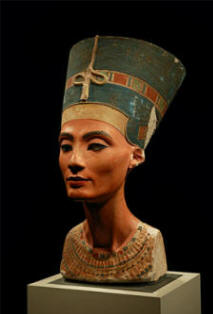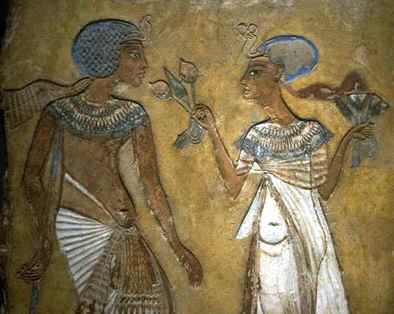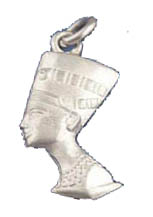Nefertiti - The beautiful queen of Egypt
 The name Nefertiti means "The beautiful one has come" in the
Egyptian language reveals the extraordinary beauty of an Egyptian queen whose
bust was discovered in Amarna in Upper Egypt. The name Nefertiti means "The beautiful one has come" in the
Egyptian language reveals the extraordinary beauty of an Egyptian queen whose
bust was discovered in Amarna in Upper Egypt.
Although Nefertiti was the great wife of Akhenaton her origin has been the
subject of much speculation and some historians claim that she was married or
intended for Amenhotep III. Most historians today believe Nefertiti was the
daughter of Aye the trusted adviser of Akhenaton. Aye was the brother of queen
Tye the great wife of Amenhotep III.
Nefertiti and Akhenaton had six daughters. Their family affection was clear
enough from the family portraits.
Nefertiti played an important role in assisting her husband in his efforts to
convert Egypt to monotheism which was a religious revolution at the time.
There were multiple Egyptian Gods and Goddesses worshiped by common
people. Each city had its own deity and an individual might feel attached to a
certain God but no one questioned the existence of other Gods.
Akhenaton decided to go against tradition and convert Egypt to monotheism to
worship the one God Aton (or Aten) the Sun Disc . Nefertiti was a great
supporter of Akhenaten to spread the new religion. They had closed the other
Gods' temples and moved the capital city to a remote part of the land Amarna.
Atenism was largely irrelevant to the common people and the temples to other
gods were closed. Workers were sent to erase the name of Amun wherever it
appeared. Akhenaten appeared to lose interest and authority in the country at
large.
By the 14th year of Akhenaton's reign Nefertiti had disappeared from view.
There is no record of her death nor her mummy has been found. Some historians
believe that Nefertiti changed her name to Smenkhkare, adopted the guise of a
man and ruled as co-regent with her husband. The majority view is that
Nefertiti died of natural causes (possibly the plague).
Akhenaton died after 17 years of his reign in mysterious circumstances and
his mummy has not been found.
Smenkhkare appears to have been
co-regent for three years and to have died either just before or just after
Akhenaton. Tutankhamun inherited the throne
next and in his reign Egypt began the process of restoring the old religion.

queen Nefertiti with her husband Akhenaton
Nefertiti bust
The fame that Nefertiti has gained over the
years in modern times maybe contributed to a great extent to the discovery of
its statue known as Nefertiti bust which was found in Amarna Egypt in 1912. The
original famous Nefertiti bust was found among other unfinished busts by the
German archaeologist Ludwig Borchardt who led a team of the German Oriental
company (Deutsche Orient-Gesellschaft). It was shipped to Germany in 1913 where
it was kept in the residence of James Simon the sponsor of the excavation and
then moved to the Berlin Museum the same year but was kept a secret until
finally displayed in 1924. The bust moved to several locations in Germany. It is
currently displayed in the Neues Museum Berlin. The bust of Nefertiti
height is 47 cm and weighs around 20 kg (44 lb). It is made of a limestone core
covered with painted stucco layers. The face is completely symmetrical and
almost intact, but the left eye lacks the inlay present in the right.
There has been intense discussions about the
repatriation of the Nefertiti bust to Egypt. Ever since the unveil of the
discovery of the Nefertiti bust, there have been Negotiations between the
Egyptian and German governments to return the bust to Egypt as the bust was
moved illegally to Germany but it has not been decided yet by the German
authorities if the bust would be returned to Egypt.
Both Egypt and Berlin view the Nefertiti bust as a
symbol of them and as it has been a precious item to possess, each party
refuses to step back on its demand to have it on its land.
Books about Nefertiti
Egyptian Jewelry
 |
SP02
silver Nefertiti pendant
4.7cm length
Price $20
Buy |
We have a collection of silver Egyptian
jewelry of Nefertiti, Cleopatra, Tutankhamun and other ancient
Egyptian figures. To browse the silver jewelry collection :
click here |
|
More Ancient Egyptian history articles:
|